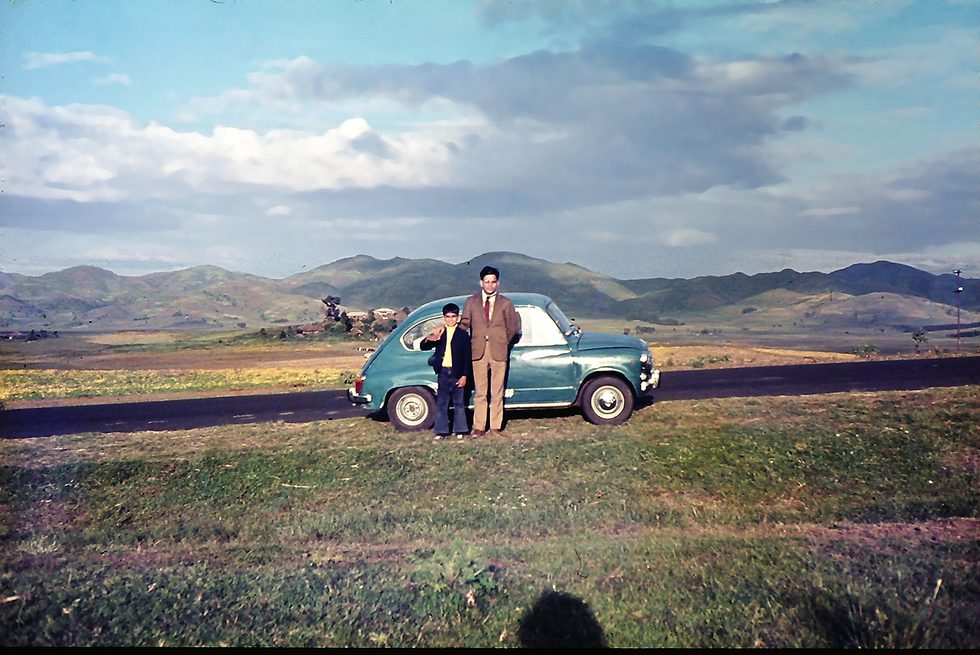
My father worked for the Indian Foreign Service from 1955 to 1982. During this period our nuclear family lived in several countries across Africa, South America, Europe, and South Asia. As a representative of the new nation-state of India, my father often spoke of the responsibility and the tremendous honor of embodying the country’s interests abroad. This task went beyond his official duties and necessitated that he—and, by extension, we—embrace practices, rituals, and even desires that were decidedly modern. Image-making was, for him, a key practice insofar as it provided him the socio-technological means to fashion himself as an Indian while producing an indexical record of his family as representatives of the new nation-state in various stations across the world.
Over the years my father conscripted my mother into his image-making project. Together, they created a photographic record of each of our postings that spanned roughly thirty years. Eventually, we moved to the United States, where my father gave up his position in the Indian embassy for the uncertainty and fuzzy, tenuous belonging that a nongovernmental job and, eventually, U.S. citizenship would entail for him and, more ambiguously, for us. The intimate visual record of our time as representatives of India, however, persists. When interpreted as an archive, these images offer our biography as a Foreign Service family as part of an early history of postcolonial diplomacy when the potential to create new relations with other nations, particularly those that had also recently emerged from colonial rule, were intertwined with aspirations to become idealized modern subjects. To dress differently; to have different hairstyles; to own a car. To take pictures. In the images that comprise this archive we were cast as a prototypical upper-caste modern Indian family who were able to disconnect from extended kin networks, create distance from tradition, and remain happily ignorant of the everyday fits and starts of nation-building back home even as we represented India abroad.
In this photo-essay I use the term postcolonial modernity to capture how this entanglement of subject and nation formation emerges in the images that comprise my family’s archive. In the images my father and mother produced, I locate the ways in which a gesture, a sartorial choice, even an orchestrated group photo can offer a trace of the aspirations that my family held as Indians who represented the nation abroad. These images simultaneously open up the possibility to engage with the twentieth-century historical events that we were privileged to witness from a position of intimate encounter. As a Foreign Service family, we were regularly invited to diplomatic events. My father would bring his camera to each and every one of them. He also took pictures of a more mundane, everyday kind of historical unfolding, one that positioned us as subjects in an emerging era of postcolonial relations between new and old nation-states.
Importantly, many of the images in my family’s archive were never printed on paper. They never found themselves in a photo album or on a wall. They were only seen when we gathered to watch the spectacle of the slide show, a familial practice that disappeared by the late 1980s after my brother and sister left home and my father began to tinker with making home movies. When I was growing up, however, my parents would regularly set up slide shows that attempted to chronologically recall our family’s route across the globe.
Even as a child I remember feeling the juxtaposition of the slide-show images as surprising, startling. Portraits of family members would give way to, for instance, a state procession. The state procession would abruptly give way to an image of a building that my father fancied in the city where we happened to be living. I also remember the social event of the slide show as fulsome and saturated with meanings that went beyond the images, linked to sound and even taste (a hot samosa from the oven, saccharine milk sweets on white ceramic dishes). In that sense, this essay, in addition to engaging with the images themselves, also seeks to think through the practice of the family slide show as a sonic (and sensorial) production of postcolonial modernity.
In her recent book, Tina Campt (2017) asks us to listen to images, whether they are the delicate prints that we find in colonial archives or the ones that live in our family scrapbooks and photo albums. She argues that attention must be paid to quiet, quotidian photographs as way of recognizing their haptic frequencies, those that don’t register as audible but impact us through vibration nonetheless. I am also interested in listening to images as they are embedded in the twentieth-century practice of the family slide show. I strain to hear the click of the button that the narrator presses to advance to the next image. The sound that directly precedes that click, that of the projector advancing. The hum of the projector’s fan. The voice of the narrator that often, I wager, belongs to the patriarch of the family as he speaks of, about, and through images. The unruly interjections and interruptions of the audience, family, and friends who might ask about missing images or wonder out loud why the chronology of the carousel or of the narrator’s story does not match their memory of past events. The sizzle of food frying in the kitchen. I also strive to hear the quieter and more specific frequencies embedded in and between the images that comprise my family’s slide show(s), wavelengths that narrate our postcolonial relations and aspirations even as they point to broader twentieth-century unfoldings.
The photographs in this photo-essay engage with this sort of listening. They demand that attention be paid to the family slide show where the sounds of collective, ritualized looking are baked into the images themselves. They mark my family’s slide show as a constitutive practice, one that leaves sonic, haptic, and optic traces of subjects, nations, history, and biography. Moreover, the images in this essay, when taken as a slide show, push us to consider archiving as an active unfolding where projection, reenactment, performance, and juxtaposition are all generative of the postcolonial imagination.
The ten images in this photo-essay offer a rough approximation of the images my mother would have selected to depict one of our postings for a slide show event and the order in which she would have organized them. The Ethiopia series featured here would, more often than not, sit somewhere toward the end of the show. It was the last posting before we became Indian immigrants in the United States. Yet, sometimes, by whim or by accident, the chronology of our trajectory would be upended. Ethiopia would begin our journey. I have provided captions for each image that, in addition to engaging with the visual material, attempt to synthesize remembered voices and sounds of the family slide show. To recollect the voices and accompanying sounds (and scents) of the event, I recently used the images to elicit recollections from my brother, sister, and mother about the scenes depicted and the slide show performances in which the images were originally embedded. Quite a bit came out of these encounters, more than I could include in this essay. What I found curious in this process of elicitation, beyond the unexpected stories that were recounted, was that the photos we used to remember together were now digital artifacts. They were no longer tethered to the materiality of the slide or the projector or the socio-technological practice of the slide show. Rather, the photos were now able to circulate through digital platforms and produced a different sort of sociability as a result.
About a decade ago my brother and his wife began the painstaking process of digitizing the family slide collection. They used Google Plus to curate and circulate the images to the rest of the family. When I looked at them online for the first time I was struck by the way in which the images eerily yet comfortingly conjured my late father’s voice, the sound of the projector, the chatter of the rest of my family as we consumed the visual record of our shared trajectory across continents. Yet this conjuring that Google enabled felt like a trick. As I sat alone in front of my laptop listening to the frequencies of faded memories, I felt the loss that comes when practices of collective recollection requiring physical presence disappear and are replaced by technologies of capture, curation, archiving, and sharing that exist in virtual space-time. I began to remember all of the gatherings of friends and family around the large carousel projector that sat, imposingly, in the center of the room. I recalled the exchange that collectively witnessing the family slide show enabled and compared it to the stark, singular nostalgic intimacy of its digital resurrection.
I sought out conversations with my mother, sister, and brother that I hoped would help me amplify the memories that the digital seemed to incompletely elicit, that would help me hear with greater fidelity the voices that murmured and the mechanical movements of the projector that felt distant and muffled when I sat in front of my computer screen. Yet even our collective act of looking and remembering was only possible through the pixellated screen of my laptop or tablet. One of my hopes for this essay is to straddle the distance between the lonely act of reading, listening, and otherwise taking in a digitized family archive and the social life of the slide show that it attempts to represent. In doing so, I offer a way to reflect on the digital present even as it opens up new vistas onto an analog past. An engagement with the family slide show, I believe, points to how twentieth-century visual technologies allow us to see, hear, and methodologically engage with how history ruptures our intimate performances of biography and how our biographies, in turn, become historical when they are digitally rendered as archives.
The slide show as an event in collective remembering isn’t mine alone to think through or recollect. From the 1950s through the 1980s, slide shows were a modern family spectacle. In the 1950s Kodak marketed thirty-five-millimeter slides with the slogan “for sparkling pictures as big as life.” Slides were a way to display large, high-quality thirty-five-millimeter images for a viewing audience. Slide shows mobilized what Walter Benjamin (2007, 239) called the “unconscious optics” of the singular image, its capacity to capture and expose what otherwise could not be seen, by offering groups an opportunity to see together. Indeed, echoing Benjamin, Ariella Azoulay (2008, 14) argues that photographs “reorganize what is accessible to the gaze.” Images, when scrutinized and particularly by a group, allow us to see not only what the photographer intended to capture but to apprehend something of the texture of life lived as it is embedded in larger narratives of change. Yet, like film, slideshows also generated juxtapositions between images. These adjacencies told stories by generating unanticipated connections between and across each image. As Tina Weidner argues, slides offered “a hybrid medium that belongs on a continuum between still photography and motion-picture film and combines qualities of both technologies.”
The slide show restaged in this photo-essay includes images that capture the pomp and circumstance of then–Indian President V. V. Giri’s 1972 visit to meet H. I. M. Haile Selassie, which are followed by portraits of my family in Ethiopia, interspersed with street photographs my father took while on his ambles through Addis Ababa. Certainly, these images can be engaged with and read individually. Each image opens up a way of seeing the postcolonial anew, as a set of relations within and between families and across nations striving to create new frameworks of engagement while also maintaining old ones. Yet these images should also be experienced as a series, as photographs that speak to one another. Seen in juxtaposition, they create layers of interspersed meaning that link fatherhood to nationhood, desire to the sartorial specificities of 1970s modernity, or caste and class privilege to mobility. The series of images that I have shared should also, of course, be engaged with as a sensorial spectacle that moves beyond the single frame or even the juxtaposition of multiple images. Put simply, slide shows were more than just a visual assembly and my attempt at reproducing their effects necessitate a close engagement with other sensoria.
The accompanying narration and other irruptions of aural performativity complicated what intimate and historical traces one could see and hear. Indeed, the slide show relied on this live narration and its interruptions to make visible certain connections between images. The family’s vocal rehearsal of its shared biography and the larger histories that frame it, however, also erased certain relationships between the images. The connections that were made visible (or that were erased) changed, slightly or profoundly, with each showing. In part, this was because the curator of the carousel could change the sequencing of the images, thereby altering their relationship to one another. These changes elicited different conversations. Each slide show, depending on who was in the room, pushed those of us who were gathered to narrate the relationships between the images in different ways. Of course, some stories were told no matter what order the carousel was arranged in, no matter who was invited to participate in the ritual of collective viewing.
When my father would narrate the slide show depicting our time in Ethiopia he would always tell two stories, adding or omitting details on each occasion. The first was of his visit to Haile Selassie’s palace, where he dined on gold plates and saw a lion walking freely through the halls. The other was a story I have partially narrated in the image captions here, detailing my father’s frantic drive to the hospital with my mother during a curfew set up by communist insurgents supported by the Soviet Union after Selassie was placed under house arrest. I hear these intimate stories each time I look at these images, despite their now digital existence. I listen carefully to the way these stories are told and remember in each image the small details of their telling. These stories, of course, obscure other aspects of the images themselves. They push us away from asking who these strangers, whose images appear unexpectedly after a brief interlude of a black screen, might be. Moreover, they do not provide a context for why certain photos are framed the way they are.
By asking these questions of these images and listening carefully to their responses, by taking up the spirit of Campt’s haptic engagement with the colonial archive, another narrative emerges. This story, found in the hum of the projector, the narrow beam of light that carries images to the wall, even in the polyphonic performance of the family slide show, evokes a tale of twentieth-century solidarity between postcolonial nations seeking a path of nonalignment and Third World solidarity. It was, at least initially, in this spirit that I curated the ten images that constitute this photo-essay, ten images that link my family’s journey as representatives of India, their aspirations to be modern, and the historical events in which we became entangled during this trajectory.
In this story, my family’s time in Ethiopia and our witnessing of Giri’s visit and the overthrow of Selassie is the postscript to the anticolonial struggles of India and Ethiopia. It opens up the possibility of bringing other archives to bear on a reading of the slide show. For instance, we could take Pundit Jawaharlal Nehru’s letter in support of Ethiopia’s struggle against Italian imperialism in 1935 amid India’s own struggle for independence as a key text that allows us to understand my family slide show as an index of Southern relations and the hopefulness of better things to come. Indeed, this letter marked a beginning to a twentieth- century relationship between countries that would have India sending doctors and teachers to Ethiopia to assist in development projects in the decades after independence. We might also “hear” this slide show as a precursor to what was to come for Ethiopia after our departure, when nonalignment gave way to the rise of Soviet influence.
We left Ethiopia soon after Selassie’s death and returned to Delhi before our next and final posting in the United States. The slides speak to these movements as well. Me on my father’s shoulders, circa 1978, in a crowd gathered at India Gate to cheer for the arrival of then–U.S. President Jimmy Carter in what marked the first official U.S. state visit since Indian independence. My brother posing in front of the tiger exhibition at the National Zoo in Washington, DC a few years later, proudly wearing a brand new pair of blue jeans. These images harken to an American future for my family and a growing ambivalence in our desire to continue representing India. Moreover, the images that my mother might have curated to follow those collected in Ethiopia prognosticate a reordering of the world system shaped by the singularity of American exceptionalism.

Download “Archiving Postcolonial Modernity: The Foreign Service Family Slide Show” by Ethiraj Gabriel Dattatreyan as a pdf booklet.
Photos
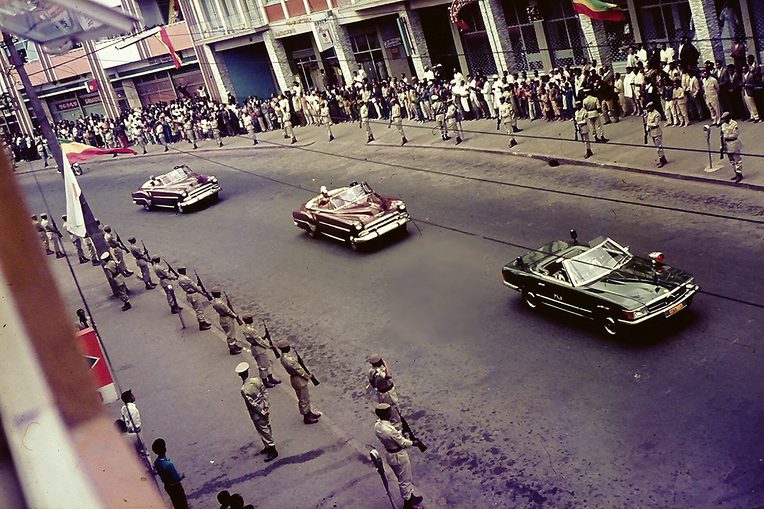
The hum of the projector fills the room as a hush falls over the group. A beam of light produces a singular image that is projected onto a makeshift screen consisting of a white sheet pulled taut on a wall. The show is about to begin. My dad’s voice fills the room. “We’re starting with Addis? What happened to Stockholm or Islamabad? Where are the slides from Buenos Aires?” My mom shouts from the kitchen: “They are coming later!” At first my dad grumbles something about things being out of order. Then he begins to talk about the image in front of us. “This was when V. V. Giri visited Addis. I leaned out of the building and snapped this photo.” My sister asks: “Weren’t you scared of falling?”

The only trace of my mother in this image is the shadow on the bottom edge of the image, a silhouette of her hair. My father often tasked her with taking pictures, especially when he wanted to be in front of, rather than behind the camera. The shadow of her head, backlit by the sun, reveals the hairstyle she wore in the 1970s. It was a stylish bob, worn almost like a beehive. I remember vividly when we went back to India for visits in the 1980s and 1990s and my mother would express embarrassment that she no longer had long hair like her sisters or her cousins, hair that could be braided into a single plait and adorned with flowers. She also no longer wore saris exclusively, or even salwar kameez: the North Indian dress that signifies feminine modernity in South Asia.
Her changing hairstyle and fashion sense at once marked our collective aspiration to become modern subjects and our gradual distancing from South Indian Brahminical tradition. “Remember when I bought that Fiat? Brand-new, it was my first car,” my father says. My sister interjects: “It was so small and so cute.” My father continues: “Ethiopia had the hardest driving test. I was asked to take my car, this little car, to the steepest hill in Addis. The driving instructor then asked me to balance the car on the hill without using the brake, just the clutch.”

“He liked to walk in the city. Sometimes he would go with his camera,” my mother remarks as we collectively look at the greenish hues of a contemporary building in Addis. “You know, before he started working with the embassy your dad wanted to become a journalist? He was really interested in writing and taking pictures. He always enjoyed photography.” My father’s desire to document everyday life, to move beyond the edges of our familial experiences and shoot the ephemeral and the unexpected—this impulse of the street photographer—is etched into our postcolonial family archive. Snapshots of city streets, black and white images of Buenos Aires during Juan Perón’s presidency, the technicolor Kodachrome renditions of 1960s Stockholm: these images capture the breadth of my family’s travels and the changing urbanity of the twentieth century.
My sister asks, “why is that slide so green?” My mother responds: “Because it’s old. The slides have been sitting in a box. I don’t remember the the slide looking like that many years ago.”
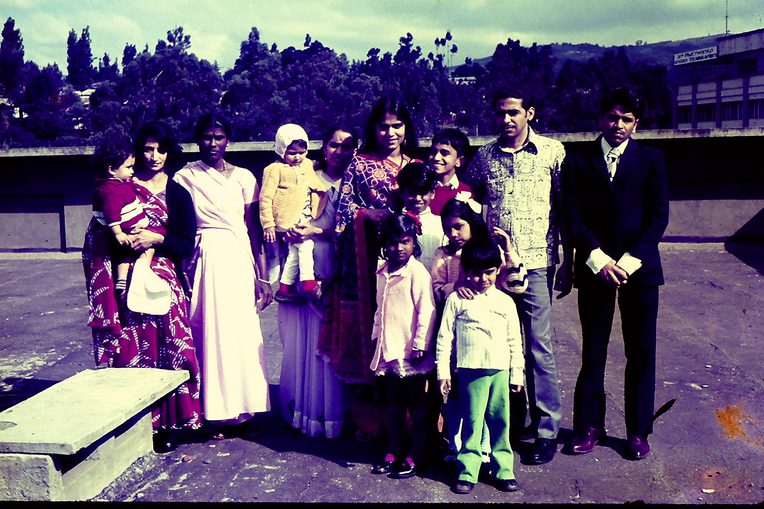
The embassy group photograph. In each country, in each city, this image is reproduced. The specific cast of characters changes based on who was stationed in each place and where we found ourselves, but the framing remains the same. The men stand on one side. The women and children on the other. Occasionally, the ayah (nanny) that a family has brought with them from India, undoubtedly a woman from a lower-caste background, awkwardly stands with the group. In each posting, these families became our connection to India. They were a way for us to recreate home, with all the caste, class, and cultural implications that this suggests, all while collectively celebrating the good fortune and upper-caste privilege of being able to claim a traveling subjectivity. Punjabi, Marathi, Hindi, Telugu, and Tamil speakers who gathered under the banner of India all spoke English to one another in our homes away from home. Yet we still reproduced an older, enduring social order rooted in caste, gender, and religious belonging.
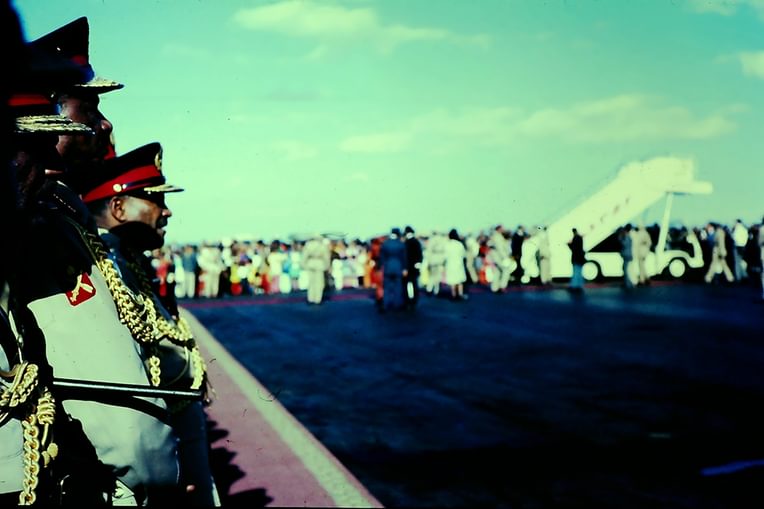
This image reveals the access that my father, as a government employee, had in those days. What a privilege to stand with H. I. M Haile Selassie’s honor guard to receive President V. V. Giri as he stepped off his specially commissioned Air India flight. This image foreshadows the Soviet-backed revolution that overthrew the emperor only a year and a half after this state visit. “When the revolution began,” my father explains, “the streets were empty. We were asked by our higher-ups not to go outside at night. I was given a pass stating that I was on a diplomatic mission to take your mother to the hospital because you were due to arrive soon! I was to show the pass to the security officers at the checkpoints. When it was time for your mother to give birth, we left your brother with Buzunesh [the Ethiopian maid we employed] and rushed to the hospital. The guards at the first checkpoint pointed guns at us in the car.”
My mother interjects: “I was so scared and also so ready to give birth! You were coming so fast. The guards let us through but only to the Empress Zewditu hospital. Our doctor worked at another hospital. They fought with us, saying they couldn’t admit us. I had to yell that you were coming right then, and there was no other place where they could admit me.”

When my father moved from still photography to home video in the late 1980s he became increasingly obsessed with catching the intimate moments of our family life. He would constantly film himself and, sometimes, us doing everyday things. My father often asked my mother to shoot him in various angles carrying out various daily tasks. When I was thirteen and we lived in New York, he finally bought a tripod and my mom was absolved of this labor. His obsession with the mundane and the intimate, however, preceded his interest in video and makes itself visible in the still images that comprise the family slide show. “She always fumbled with the camera so the photo is not the best,” my father casually remarks. “I did not fumble with the camera,” my mother shoots back. “I actually took some of the best photos.” “That’s what you think,” he responds.

My mom always ordered the images in the slide-show carousel. I can’t remember a single time when she hadn’t carefully (or, one could argue, haphazardly) put together the carousel in the hours before we gathered for a collective viewing. The slides always moved idiosyncratically between capturing the intimacy of family life and the vast sweep of history. This was the era when pilots were received with pomp and circumstance. They were included among the dignitaries, in this case Selassie and Giri. My father metaphorically stands in the wings of the action. He is neither backstage nor is he front and center, viewing the spectacle and capturing it officially for posterity. The wings allowed him to frame the Air India plane and its pilots and stewards as central actors in this historic moment of diplomacy.

I see this image with the airport in the distance and the dashboard of the Fiat in the foreground, and I hear the sound of car tires as my father pulled off to the side of the road to get this shot. It is the audible shift as he moved from smooth, paved asphalt to caked earth and grass. I wonder why this shot is from the passenger seat rather than the driver’s seat, where he would presumably have been sitting. Did he shimmy across to the other side of the car or did he open the door and walk around it taking a deep breath before he opened the passenger door to sit down and frame this image? Or was there someone else driving? Did that someone, possibly one of my father’s coworkers, step out of the car to find a quiet place to relieve himself and, thus, provide my father the moment he needed to compose this optical rumination on airports, cars, and modernity? What sonically charged forensics of twentieth-century image-making emerge when we begin to ask these questions?
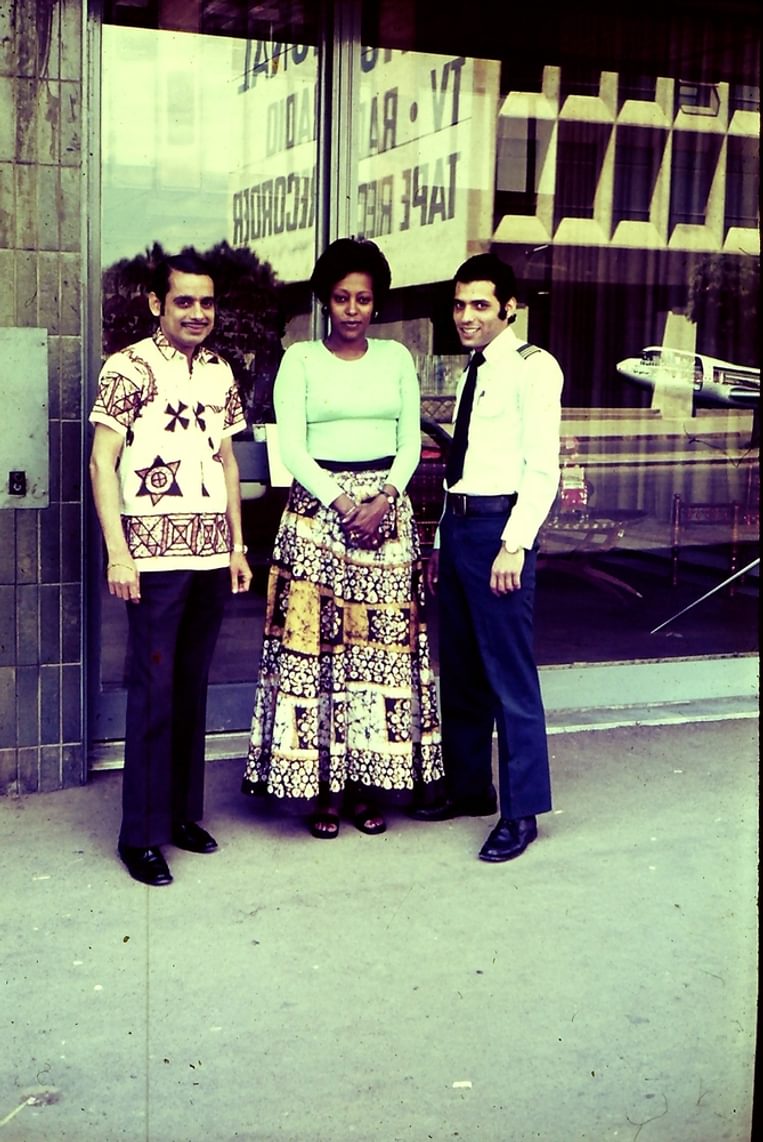
“Who are these people?” asks my sister. My father responds: “The man on the left worked with me at the embassy. His name was Khanna, I think. He was a confirmed bachelor. He is standing with an Air India pilot and a woman who worked at the airport. I walked around the airport after the flight arrived and took a few pictures.” We quickly pass over this slide and onto the next during the slide show. It’s only years later that I find myself lingering on these sorts of images, the images of strangers that accidentally made it into our family spectacle, embedded in our archive. I wonder about these people that my father and, sometimes, my entire family briefly encountered. What happened to them in the years that followed? What lives did they live? Why was marking someone like Khanna as a bachelor important to my father?

The stately red carpet. I can hear it unfurling, two men in uniform rolling it out lengthwise until it reaches the edge of the staircase. The redness of the carpet is striking. It is as if the likeness of the carpet has resisted aging while the rest of the image has faded with time. What does this image portend and what will the next image be? The sound of the projector’s whirring motor grows louder as we fall into a hush. The click signals the image to come. Another place and time on our trajectory to the present—on our path to realize a subjectivity not yet determined, a subjectivity undoubtedly rooted in the national and simultaneously escaping its bounds.
References
Azoulay, Ariela. 2008. The Civil Contract of Photography. Cambridge, Mass.: MIT Press.
Benjamin, Walter. 1968. “The Work of Art in the Age of Mechanical Reproduction.” In Illuminations: Essays and Reflections, edited by Hannah Arendt and translated by Harry Zohn, 217–51. New York: Schocken. Originally published in 1936.
Campt, Tina. 2017. Listening to Images. Durham, N.C.: Duke University Press.